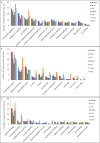Proteomic analysis and cross species comparison of casein fractions from the milk of dairy animals
- PMID: 28240229
- PMCID: PMC5327394
- DOI: 10.1038/srep43020
Proteomic analysis and cross species comparison of casein fractions from the milk of dairy animals
Abstract
Casein micelles contribute to the physicochemical properties of milk and may also influence its functionality. At present, however, there is an incomplete understanding of the casein micelle associated proteins and its diversity among the milk obtained from different species. Therefore, milk samples were collected from seven dairy animals groups, casein fractions were prepared by ultracentrifugation and their constituent proteins were identified by liquid chromatography tandem mass spectrometry. A total of 193 distinct proteins were identified among all the casein micelle preparations. Protein interaction analysis indicated that caseins could interact with major whey proteins, including β-lactoglobulin, α-lactalbumin, lactoferrin, and serum albumin, and then whey proteins interacted with other proteins. Pathway analysis found that the peroxisome proliferator-activated receptor signaling pathway is shared among the studied animals. Additionally, galactose metabolism pathway is also found to be commonly involved for proteins derived from camel and horse milk. According to the similarity of casein micelle proteomes, two major sample clusters were classified into ruminant animals (Holstein and Jersey cows, buffaloes, yaks, and goats) and non-ruminants (camels and horses). Our results provide new insights into the protein profile associated with casein micelles and the functionality of the casein micelle from the studied animals.
Conflict of interest statement
The authors declare no competing financial interests.
Figures



Similar articles
-
N-glycosylation proteomic characterization and cross-species comparison of milk whey proteins from dairy animals.Proteomics. 2017 May;17(9). doi: 10.1002/pmic.201600434. Proteomics. 2017. PMID: 28266172
-
Comparison of the principal proteins in bovine, caprine, buffalo, equine and camel milk.J Dairy Res. 2012 May;79(2):185-91. doi: 10.1017/S0022029912000015. Epub 2012 Feb 27. J Dairy Res. 2012. PMID: 22365180
-
Distribution and variation in proteins of casein micellar fractions response to heat-treatment from five dairy species.Food Chem. 2021 Dec 15;365:130640. doi: 10.1016/j.foodchem.2021.130640. Epub 2021 Jul 20. Food Chem. 2021. PMID: 34329874
-
High pressure-induced changes in bovine milk proteins: a review.Biochim Biophys Acta. 2006 Mar;1764(3):593-8. doi: 10.1016/j.bbapap.2005.11.010. Epub 2005 Dec 19. Biochim Biophys Acta. 2006. PMID: 16410058 Review.
-
Invited review: Caseins and the casein micelle: their biological functions, structures, and behavior in foods.J Dairy Sci. 2013 Oct;96(10):6127-46. doi: 10.3168/jds.2013-6831. Epub 2013 Aug 16. J Dairy Sci. 2013. PMID: 23958008 Review.
Cited by
-
Magnetite nanoparticles coated with chitosan and polyethylenimine as anion exchanger for sorptive enrichment of phosphopeptides.Mikrochim Acta. 2019 Nov 28;186(12):852. doi: 10.1007/s00604-019-3971-y. Mikrochim Acta. 2019. PMID: 31776681
-
Optimization of Protein Extraction Method for 2DE Proteomics of Goat's Milk.Molecules. 2020 Jun 5;25(11):2625. doi: 10.3390/molecules25112625. Molecules. 2020. PMID: 32516945 Free PMC article.
-
Antibodies, Nanobodies, or Aptamers-Which Is Best for Deciphering the Proteomes of Non-Model Species?Int J Mol Sci. 2020 Apr 3;21(7):2485. doi: 10.3390/ijms21072485. Int J Mol Sci. 2020. PMID: 32260091 Free PMC article. Review.
-
Porcine milk small extracellular vesicles modulate peripheral blood mononuclear cell proteome in vitro.Sci Rep. 2025 Mar 8;15(1):8069. doi: 10.1038/s41598-025-92550-3. Sci Rep. 2025. PMID: 40055486 Free PMC article.
-
Bactrian Camel Milk: Chemical Composition, Bioactivities, Processing Techniques, and Economic Potential in China.Molecules. 2024 Oct 2;29(19):4680. doi: 10.3390/molecules29194680. Molecules. 2024. PMID: 39407609 Free PMC article. Review.
References
-
- Farrell H. M. Jr, Malin E. L., Brown E. M. & Qi P. X. Casein micelle structure: What can be learned from milk synthesis and structural biology? Curr Opin Colloid Interface Sci 11, 135–147 (2006).
-
- McMahon D. J. & Oommen B. S. Supramolecular structure of the casein micelle. J Dairy Sci 91, 1709–1721 (2008). - PubMed
-
- Holt C., Carver J. A., Ecroyd H. & Thorn D. C. Invited review: Caseins and the casein micelle: their biological functions, structures, and behavior in foods. J Dairy Sci 96, 6127–6146 (2013). - PubMed
-
- Semo E., Kesselman E., Danino D. & Livney Y. D. Casein micelle as a natural nano-capsular vehicle for nutraceuticals. Food Hydrocoll 21, 936–942 (2007).
-
- Ono T., Kohno H., Odagiri S. & Takagi T. Subunit components of casein micelles from bovine, ovine, caprine and equine milks. J Dairy Res 56, 61–68 (1989).
Publication types
MeSH terms
Substances
LinkOut - more resources
Full Text Sources
Other Literature Sources

